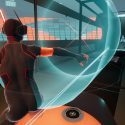Originally starting its life as an experimental VR project called ‘Project Arena’, the competitive-focused VR sport Sparc launches today on PSVR.
Update (8/29/17): Sparc launches today on PSVR priced at $30 / €30 / £23. Because the game is primarily focused on 1v1 multiplayer gameplay, there was no online population available ahead of the game’s release for us to clock enough game time for a full review. After a pre-release game session with one of the game’s developers, however, we have some hands-on thoughts to share.
Sparc Hands-on
Sparc is primarily a multiplayer game, though it does feature a series of challenge modes which have leaderboards for those seeking a high score. The core of the game involves two players facing each other at opposite ends of a corridor. Each player has a glowing ball which they throw at the opposing player with the hopes of hitting the opponent’s body to score a point. The opponent can dodge out of the way of the incoming ball, or use their deflector shield (only available when grasping their own ball) to bat the ball away. The deflector shield is useful but depletes after one hit from the opponent’s ball. You’ll need to throw your ball toward the opponent and have it return in order to revive the shield.
As you can imagine, with PSVR’s less-than-stellar tracking, having your tracking camera setup just right is important to success in Sparc; you’ll want to make sure your arms don’t exit the tracking volume when at their maximum extension in all directions. It wasn’t until I tweaked my own setup (and a fair amount of practice) that I felt like I was able to achieve reasonably accurate throws. CCP has lathered on a fair amount of aim assist to help with this (though it is reduced in the ‘Advanced’ game mode which is designed for greater levels of competition).
Aside from throwing glowing balls at your opponent and hoping to score a hit, Sparc offers players a fairly customizable avatar in a surprisingly functional configuration interface. You’ll be able to outfit your futuristic-looking avatar with different colored skins, jerseys, hairstyles, eye glasses, face-masks, and more, and many of the items can be colorized to your desire. The result is suitably futuristic and fit looking avatars that feel right at home in this sci-fi VR sport.
For a multiplayer-focused game, keeping players coming back for more is hugely important to the game’s success. It will take more hands-on time to determine if Sparc has the competitive allure to draw folks back in after the game’s initial novelty wears off.
Sparc is PSVR exclusive for now, but the developers say they’ll be talking about additional platform support later this year. That could mean that the game will find its way to the Rift and Vive (after all, CCP’s Eve Valkyrie is one of our top recommended multiplayer VR games with crossplay support), though it isn’t clear if the improved tracking of the Rift and Vive would lead to too significant of an advantage that PSVR players would need to stay in a league with their own kind.
Update (07/26/17): CCP today revealed in a Sony blogpost that Sparc will be launching on PSVR August 29th. Before launch, the studio plans on teasing more character customization as well as taking a build to Gamescom where they’ll be demoing Sparc’s single-player challenges, a series of timed events that test throwing and deflection accuracy in an environment designed to improve skills and help prepare players for human opponents.
Original Article (06/13/17): Developers CCP Games, famous for the persistent MMORPG Eve Online, have been at the forefront of VR development for several years, creating the successful VR spin-off titles Eve: Valkyrie and Gunjack. Sparc is the company’s first non-Eve universe title, being presented as an entirely separate, VR sports game.
Once known as Project Arena, the game is the result of early experimentation with VR motion control from CCP’s Atlanta studio. The prototype was already in very impressive shape during my hands-on at Eve Fanfest 2016; its particular style of energetic action combined with spectator features struck me as a great candidate for a true VR sports game.
When the project reemerged as Sparc, it had embraced the sports angle in its design aesthetic, with more tangible ball projectiles rather than discs, and the robotic avatars had received an athletic makeover. Now that the game is nearing launch, CCP is pushing this angle further, coining the term ‘vSport’, and claiming to be the ‘first-of-its-kind, full-body virtual sport’.
The spectator feature has been retained, which acts as a free-form social area to queue up for the next match, and to watch the action ‘courtside’. According to the E3 press release, the game will include “multiple two-player game modes as well as a selection of single-player challenges and training modes, plus a wide range of visually striking customization and personalization options for competitors.”
At our hands-on at GDC 2017, and at this year’s Eve Fanfest, the game was still being discussed as a multi-platform title, due to launch on Vive, Rift and PSVR in 2017, so there must have been a recent decision to introduce a period of timed exclusivity for PSVR. It’s unclear how long this exclusivity will last, but it sounds like PC VR gamers will have to wait until 2018 to play Sparc.
“With Sparc, we’ve set out to deliver an original sport for the current generation of VR hardware,” said Morgan Godat, executive producer at CCP Games’ Atlanta studio. “We want to create plasma-clad sporting champions in living rooms via the virtual court, where challengers will meet and compete with other players from around the world.”









